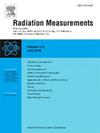一种评估单粒发光检测串扰的新方法
IF 2.2
3区 物理与天体物理
Q2 NUCLEAR SCIENCE & TECHNOLOGY
引用次数: 0
摘要
EMCCD相机的发光成像是一种创新的单粒发光检测方法。理论上,它允许在圆盘上随机放置颗粒,但在实践中,将光子归因于特定颗粒仍然是不可能实现的。目前,主要使用固定晶粒位置的单晶粒圆盘,尽管这些圆盘仍然容易受到串扰的影响,例如相邻晶粒的发光信号重叠。识别、校正或消除串扰的标准化方法尚未出现。本文介绍了空间自相关度量Moran’s I作为单粒发光检测中串扰评估的新方法。通过对诱导串扰的模拟,我们证明了当在其伪p值范围内解释时,Moran's I可以有效地检测到串扰。这些结果与在测量的发光数据集上获得的结果相证实,该数据集通过增加选择用于发光信号集成的感兴趣区域(ROI)来有意增强串扰。这些模拟和测量数据的结果表明,Moran's I可以用来选择最佳的ROI直径来增强信号,同时限制串扰。最后,我们研究了模拟串扰对三种类型等效剂量分布的影响,发现正态分布不受串扰的影响,而双峰分布则变得混合,并且歪斜分布的形状发生了变化。这些结果对良好漂白、混合和非均质漂白沉积物的ROI选择具有指导意义。本文章由计算机程序翻译,如有差异,请以英文原文为准。
A novel method to assess crosstalk in single-grain luminescence detection
Luminescence imaging with an EMCCD camera is an innovative approach to single-grain luminescence detection. In theory, it allows for the random placement of grains on a disc, but in practice, attributing photons to specific grains remains unachievable. Currently, single-grain discs with fixed grain placement are primarily used, though these are still susceptible to crosstalk, e.g. overlapping of luminescence signals from adjacent grains. A standardized method for identifying, correcting, or eliminating crosstalk is not yet available. In this paper, we introduce Moran's I, a measure of spatial autocorrelation, as a novel method for assessing crosstalk in single-grain luminescence detection. Using simulations with induced crosstalk, we demonstrate that Moran's I can effectively detect crosstalk when interpreted within the context of its pseudo-p value. These results are corroborated by those obtained on a measured luminescence dataset for which crosstalk is deliberately enhanced by increasing the region of interest (ROI) selected for luminescence signal integration. These results on simulated and measured data show that Moran's I can be used to select optimal ROI diameter to enhance signals whilst limiting crosstalk. Finally, we examined the effect of modelled crosstalk on three types of equivalent-dose distributions, finding that normal distributions are unaffected by crosstalk, whereas bimodal distributions became mixed, and the shape of skewed distributions alters. These results have implications for ROI selection for well-bleached, mixed and heterogeneously bleached sediments.
求助全文
通过发布文献求助,成功后即可免费获取论文全文。
去求助
来源期刊

Radiation Measurements
工程技术-核科学技术
CiteScore
4.10
自引率
20.00%
发文量
116
审稿时长
48 days
期刊介绍:
The journal seeks to publish papers that present advances in the following areas: spontaneous and stimulated luminescence (including scintillating materials, thermoluminescence, and optically stimulated luminescence); electron spin resonance of natural and synthetic materials; the physics, design and performance of radiation measurements (including computational modelling such as electronic transport simulations); the novel basic aspects of radiation measurement in medical physics. Studies of energy-transfer phenomena, track physics and microdosimetry are also of interest to the journal.
Applications relevant to the journal, particularly where they present novel detection techniques, novel analytical approaches or novel materials, include: personal dosimetry (including dosimetric quantities, active/electronic and passive monitoring techniques for photon, neutron and charged-particle exposures); environmental dosimetry (including methodological advances and predictive models related to radon, but generally excluding local survey results of radon where the main aim is to establish the radiation risk to populations); cosmic and high-energy radiation measurements (including dosimetry, space radiation effects, and single event upsets); dosimetry-based archaeological and Quaternary dating; dosimetry-based approaches to thermochronometry; accident and retrospective dosimetry (including activation detectors), and dosimetry and measurements related to medical applications.
 求助内容:
求助内容: 应助结果提醒方式:
应助结果提醒方式:


